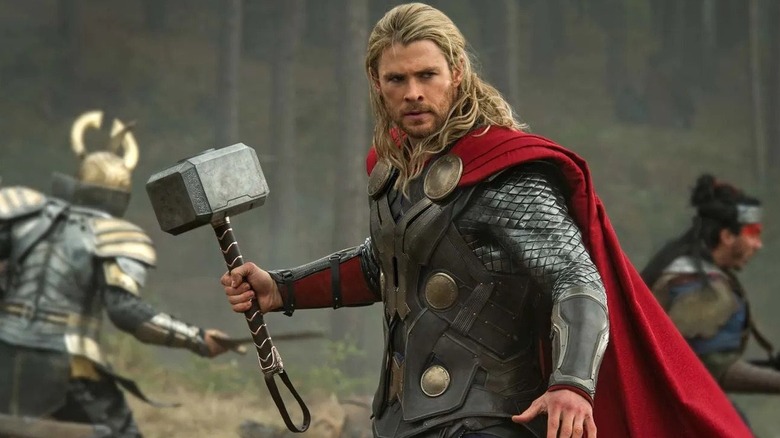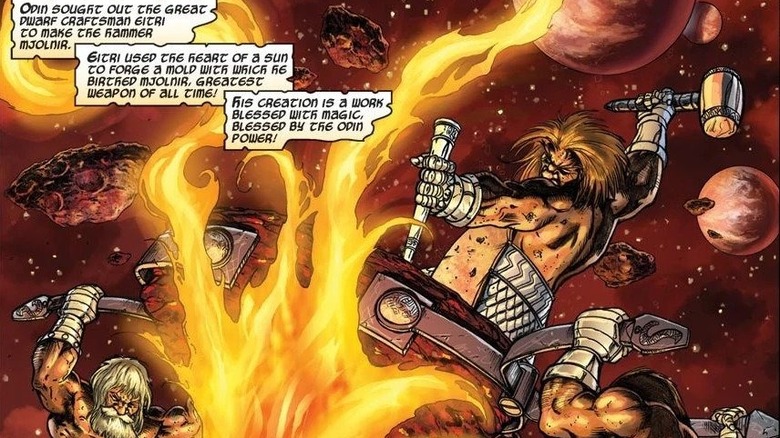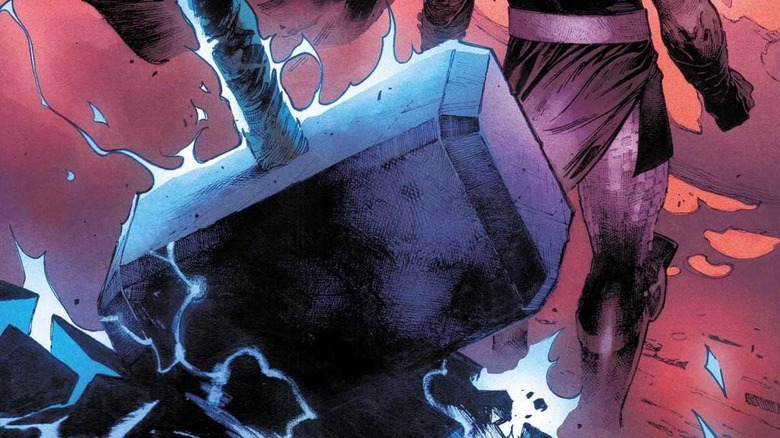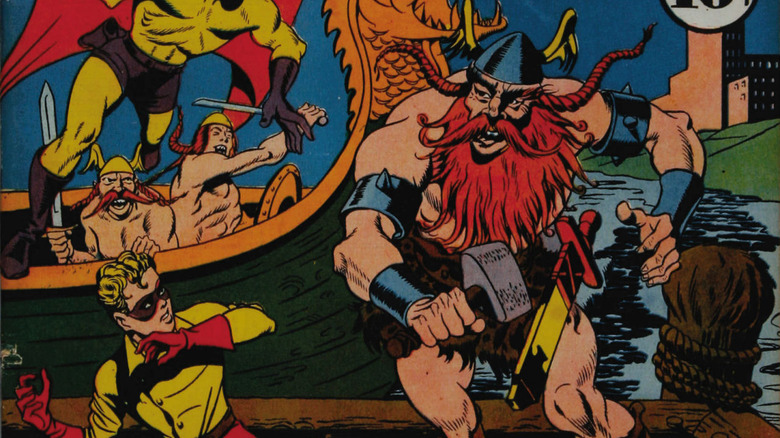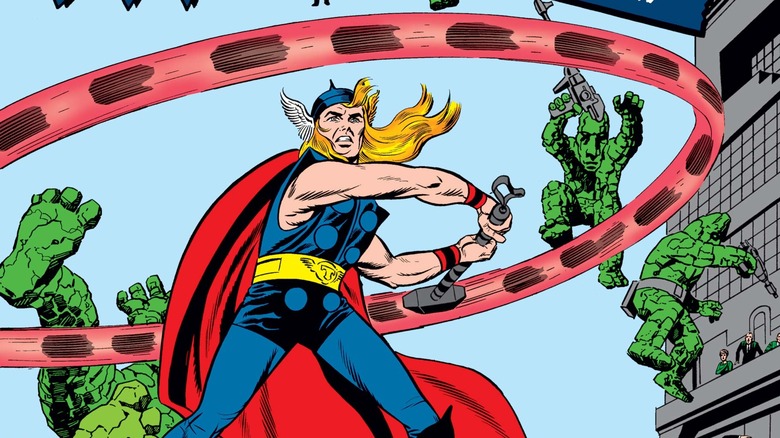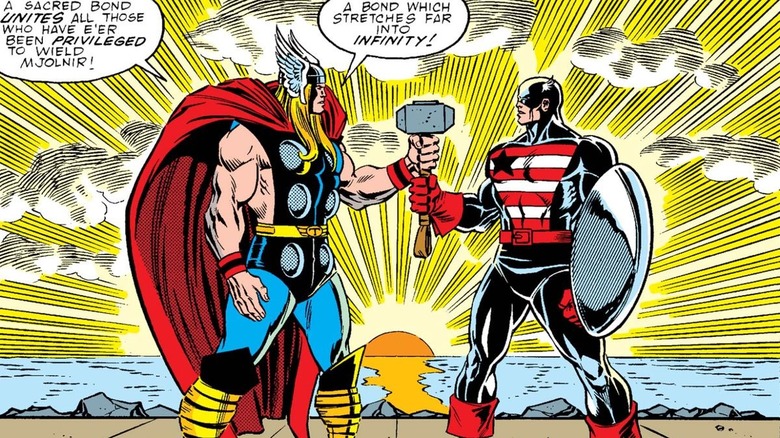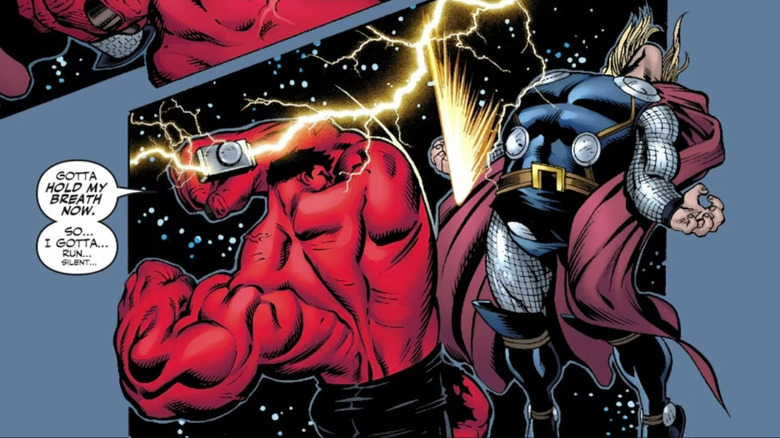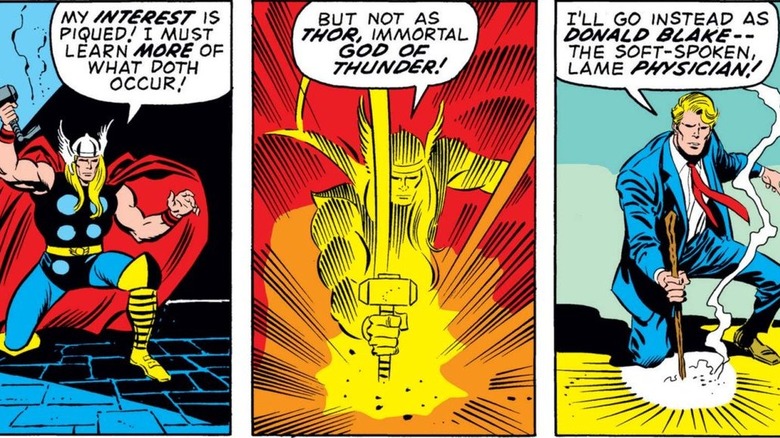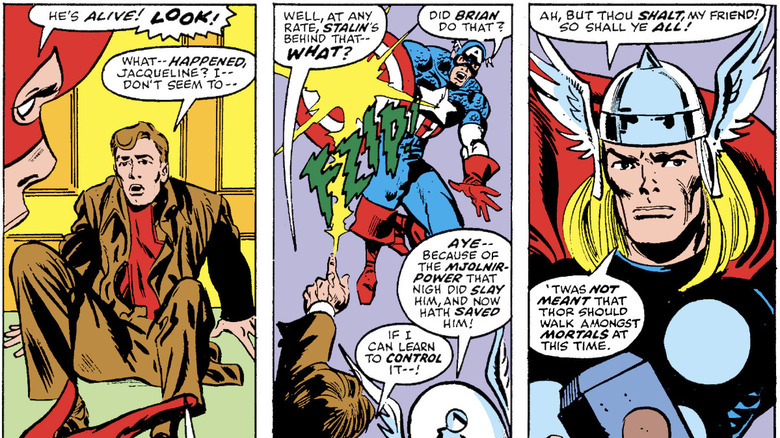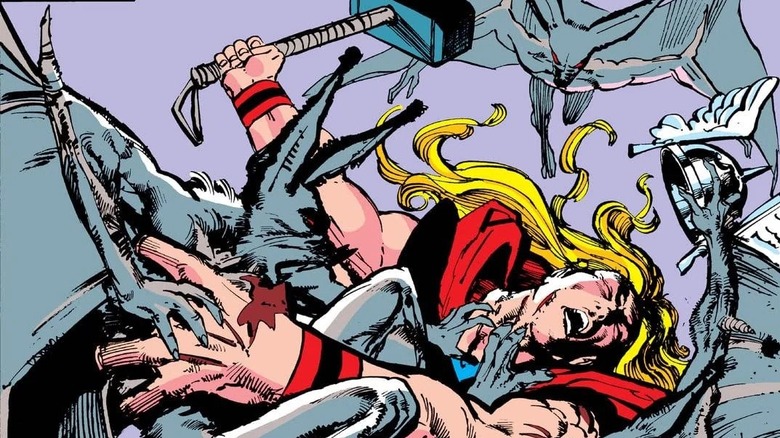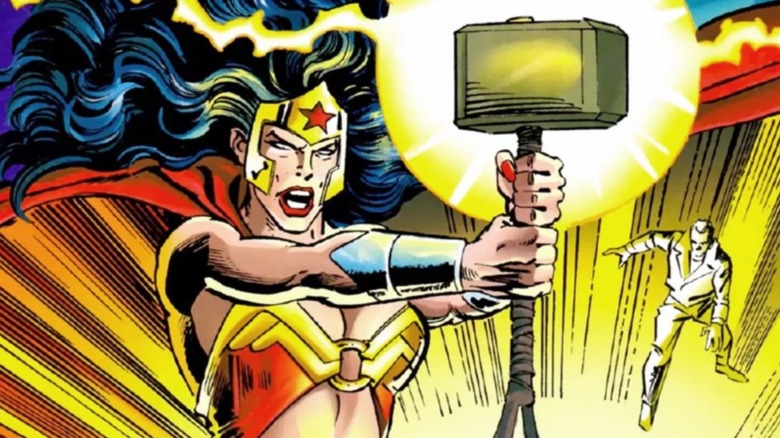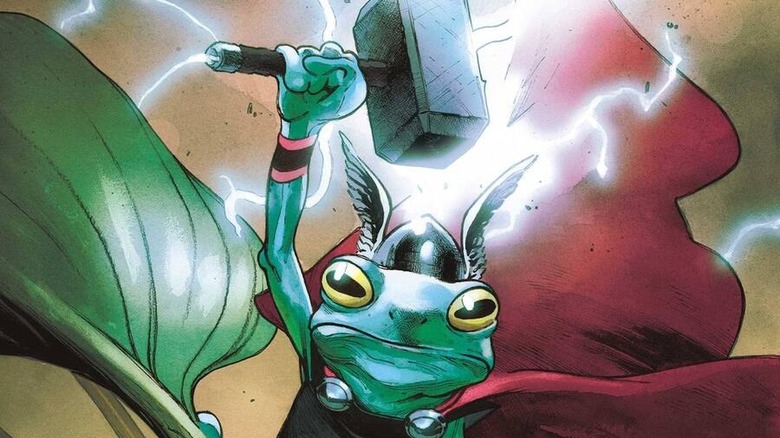Everything You Need To Know About Thor's Hammer
Thor's hammer, Mjolnir, has always been famous among Marvel comic book fans ever since it appeared in 1962's "Journey Into Mystery" #83, which also marked the introduction of the God of Thunder himself. Over the course of sixty years of ongoing Asgardian continuity, Mjolnir has accompanied Thor on countless adventures and has even been wielded by numerous heroes and villains alike (more on that later).
While Mjolnir has always been familiar to comic book readers, it has gone on to attract more mainstream awareness after making its big-screen debut at the end of 2010's "Iron Man 2" (we're not counting its cheesy live-action introduction in the 1988 TV movie "The Incredible Hulk Returns"), becoming one of the most iconic weapons in superherodom. Mjolnir has had its own crazy adventures in the Marvel Cinematic Universe, so for those of you who want to learn even more about its long and storied history here's everything you need to know about Thor's hammer.
Mjolnir was forged in the heart of a star
The origin of Mjolnir has been told and retold numerous times in the comics, but one of the elements of its backstory that has remained consistent is its cosmic creation ... but why not make the hammer in a regular old forge? "Thor" Vol. 2 #80 offers an answer: Thor's father Odin ordered the dwarf blacksmiths Eitri, Brok, and Buri to create the weapon out of the mystical Asgardian metal, Uru. However, because of Uru's unique properties, the blacksmiths needed an incredible amount of focused heat to form the metal into a hammer, so they used the power generated from a star, and thus a classic weapon was born. In fact, the process of forging Mjolnir was so intense that it almost destroyed the Earth, and it's even been posited that it may have been responsible for causing the extinction of the dinosaurs.
In "Thor: Ragnarok," Thor briefly talks about the birth of his hammer that sticks pretty close to its comic book roots. While we never saw Mjolnir's creation in the MCU, we do see Eitri direct Thor and Rocket Raccoon to create Stormbreaker in a similar way in "Avengers: Infinity War."
It has a wealth of magical abilities and powers
Mjolnir is good for far more than simply hammering nails, but anything forged by dwarves in the heart of a star is bound to carry some additional utility. One of Mjolnir's extra gifts is that of weather manipulation, enabling Thor to conjure up storms, thunder, and lightning at will. The hammer also allows Thor to fly when he spins it around at incredibly fast speeds by its lanyard, generating enough momentum to essentially pull him through the air towards his destination.
During the early days of the Marvel Comics Universe, there was not as much commitment to continuity, so many details of classic characters introduced at this time have been largely forgotten in more recent years. Mjolnir is an example of this fast-and-loose attention to canon, as the Thor story "On The Trail of The Tomorrow Man" from "Journey into Mystery" vol. 1 #86 established that the hammer can be used for time travel. That's a power that subsequent "Thor" writers largely ditched, but it is fun to see the character's creators Stan Lee and Larry Lieber having fun with the famous weapon.
It was featured in DC comics before Marvel
Mjolnir has become so synonymous with the comic book version of Thor that it can be easy to forget that Marvel did not create the iconic hammer. However, before we go all the way back to Norse mythology from centuries ago, let's jump to DC Comics only a few decades ago. That's right, Marvel Comics' main rival actually brought the mystical hammer (along with Thor) into comic book form well before Stan Lee and Larry Lieber did in 1962. To be exact, it was in "Adventure Comics" #75 from 1942 in which Mjolnir made its grand appearance in the funny books.
The momentous story was "The Villain from Valhalla!" which tells the story of the Sandman and his partner Sandy as they take on a criminal disguised as the fabled God of Thunder who's going around robbing banks with a certain electrified hammer. While this is a far cry from the actual Mjolnir, what's particularly interesting about this particular comic is the artist who did the cover for it...
Artist Jack Kirby designed is at both Marvel and DC
That's right, Jack "The King" Kirby himself did the art for two different versions of Mjolnir at two different comic book publishers. While Kirby didn't do the interior art for "Adventure Comics" #75, he did do the cover which depicted Mjolnir being wielded by Thor. While it turned out that both the Mjolnir and Thor in that story were fake, it's nice knowing that Kirby got a chance to work on the real deal around twenty years later.
The story that allowed Jack Kirby to draw the actual Mjolnir was in 1962's "Journey Into Mystery" #83, which was also the very first appearance of Marvel Comics' version of Thor. Titled "The Mighty Thor and the Stone Men from Saturn!" the three-part story follows the feeble doctor Donald Blake who, after picking up a mystical stick that is in fact Mjolnir in a different form, turns into the mighty Thor. After reclaiming the powers of his original god form, Thor uses his indestructible hammer to defeat some evil aliens from Saturn along with their Mechano-Monster.
Several other heroes have wielded Mjolnir
Fans of both the comic book and MCU version of Thor are familiar with the immortal words inscribed on Mjolnir: "Whosoever holds this hammer, if he be worthy, shall possess the power of Thor." Because it takes more than physical strength to wield the magic hammer, the list of people who have held it is pretty small. However, it is a pretty impressive list of honorable folks: Captain America was deemed worthy enough to hold it, in "Thor" Vol. 1 #390 (and seen in "Avengers: Endgame"); Squirrel Girl brandished it in the 2016 graphic novel, "The Unbeatable Squirrel Girl Beats Up the Marvel Universe;" and the Black Panther of Avengers 1,000,000 B.C. had what it took to hold it, as seen in "Avengers" Vol. 8 #36.
Another hero who was worthy enough to wield Mjolnir is Jane Foster, who took over the God of Thunder's job when he learned a secret that vastly depowered him in the 2014 "Original Sin" crossover event. Aspects of this part of the Thor mythology have been adapted into "Thor: Love and Thunder," which sees Natalie Portman returning to the role of Foster and taking Mjolnir as her own.
Several villains have wielded Mjolnir, too
Yup, several evildoers have been "worthy" enough to use Thor's hammer, although always with some sort of caveat (Mjolnir isn't something that's easy to trick). During the "Secret Empire" crossover event, it's revealed that Captain America has been working for Hydra for quite some time, and it's this malevolent version of the star-spangled Avenger who is able to brandish Mjolnir. However, it's later revealed that Madame Hydra had altered the enchantment that Mjolnir was under with the Cosmic Cube, basically cheating Hydra Cap's way to "worthiness."
Classic Hulk foe Thunderbolt Ross was able to put Mjolnir to use in "Hulk" Vol. 2 #5 during a fight with Thor while in his Red Hulk form. Again, this wasn't a case of a bad guy getting ahold of it through dishonorable means: Because their brawl took place in space, there was no solid surface that could anchor Mjolnir, allowing Red Hulk to use its weightlessness to his advantage. Another technicality that let a villain take control of Thor's hammer is when Ultimate Magneto used his magnetic powers to manipulate it in the "Ultimatum" crossover event, although he never actually grasped it.
Without Mjolnir, Thor can turn into a mere mortal
While not often addressed in more recent "Thor" comics, it's actually a fact that, at least in early adventures, if Thor was away from Mjolnir for more than sixty seconds, he would revert to his mortal Donald Blake form. For those not in the know, Donald Blake was the human vessel that Odin cast Thor into to teach him humility and was his human alias for a time when he wasn't superheroing. As Blake, Mjolnir would disguise itself as an unassuming wooden staff.
The MCU version of Thor completely ignored this part of his biography (although there is a brief nod to his Donald Blake alias in 2011's "Thor"). That was probably for the best as it would only complicate Thor by having him constrained to a time limit every time he was away from Mjolnir. However, there is a fun little wink to Mjolnir's dual identity in "Thor: Ragnarok": When Thor and Loki arrive on Earth, they don more conventional clothing with Thor turning Mjolnir into a common umbrella.
It can resurrect the dead
While Thor's hammer is used almost exclusively for destructive purposes, there was a brief time when it also had regenerative abilities. During the 1970s, Marvel Comics published a series called "Invaders," a superhero team that included the likes of Captain America, Bucky, Namor the Submariner, the original Human Torch, and others. What set this series apart from other team books at the time was that it focused on the heroes' exploits fighting Nazis and other fascist foes during WWII.
Anyway, in "Invaders" Vol. 1 #33, Thor is manipulated into working for Hitler and the Nazis, and is sent to Russia to kill Joseph Stalin, much to the dismay of the Invaders. During a battle, Thor summons a lightning bolt to kill who he thinks is Stalin, only for it to be the hero Union Jack in disguise. When Thor realizes he'd been tricked into committing such a terrible act, he uses Mjolnir to somehow retract the lightning bolt he'd conjured, thus resurrecting Union Jack. It's an unusual story and is one of the few — if not the only — instances in which Thor uses Mjolnir to undo someone's unjust death. Mjolnir already has so many abilities that resurrection just seems like overkill, even for something forged in the heart of a star.
Vampires are especially vulnerable to Mjolnir
This is yet another instance of Mjolnir having a unique ability that doesn't get much attention these days. While most people wouldn't survive even a gentle tap from Thor's hammer, it's interesting to note that vampires have a special weakness for the mystical object, as seen in "Thor" Vol 1. #332. This issue sees the God of Thunder deal with Dracula (another preexisting fictional character folded into Marvel Comics continuity) and his vampiric forces. During the battle, Thor throws Mjolnir at an undead foe only for them to explode into flame as if it came into contact with a crucifix.
Fans have yet to see Mjolnir's effect on vampires in the Marvel Cinematic Universe, but with "Eternals" setting the stage for the appearance of Blade, seeing Thor taking on some undead legions is now a possibility. Although, considering the negative reviews that "Morbius" has garnered, fans would probably prefer to see that character get some time in a ring with Thor's hammer.
Wonder Woman and Superman are worthy of wielding it
The rivalry between DC and Marvel has always been largely fan-generated. In reality, many writers, artists, editors, and other staff members have worked at both companies, and other than the fact that the two consistently compete for market share, they're actually on pretty good terms with one another.
In fact, there've been several comic book crossovers between DC and Marvel, including "DC vs. Marvel" which saw Superman battle the Hulk, Batman fight Captain America, Wolverine duke it out with Lobo, and other dream matchups. During his fight with Captain Marvel (no, not that one), Thor loses Mjolnir and is intercepted by Wonder Woman, who is able to wield it in her bout with Storm. This makes perfect sense, as Wonder Woman's strength of character and Greek god origin makes her more than worthy to pick up Thor's hammer. Fans got to see Superman wield the legendary hammer in the crossover's sequel, "JLA/Avengers" (as well as Captain America's shield). This is another situation that is hard to argue against, as everyone knows that DC's Big Blue Boy Scout has what it takes to hold Mjolnir.
There's a frog version of Thor, and thus a frog version of Mjolnir
This is a bizarre yet oddly adorable part of the mythology of Thor: During Walter Simonson's beloved run on the comic in the 1980s, Thor is turned into a frog by Loki and meets Puddlegulp, a man who was himself turned into a frog by a mystic. Puddlegulp and his fellow frogs are being besieged by some evil rats, prompting frog-Thor to help them in their battle. After helping them win the war, Thor managed to become human again and departed, but not before a tiny sliver of Mjolnir was left behind. Because of Puddlegulp's admirable character, he was able to lift the sliver which then transformed into a miniature version of Mjolnir creatively called Frogjolnir. Imbued with this amazing power, Puddlegulp (now going by Throg) teamed up with Lockjaw of the Inhumans, Lockheed of the X-Men, and other superhero pets.
While we probably won't be seeing Frogjolnir make its grand live-action appearance in the Marvel Cinematic Universe anytime soon, because there was a blink-and-you'll-miss-it cameo from Throg in "Loki," the possibility is there.
